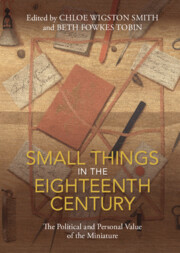Placing the minuscule under the magnifying glass, Small Things in the Eighteenth Century is an astonishingly diverse but uniformly fascinating collection of essays. From teapots, coins, and trinkets to insects, books, and beads, small things can be easy to ignore or forget. And yet in this volume small things are shown to spark big ideas, to move unnoticed through space and time, to traverse seemingly impermeable social and political boundaries. This book is a key intervention in the field and will demand the attention of literary scholars, art and design historians, curators, and anybody interested in gaining a richer sense of everyday life during the eighteenth century.
Joseph Hone - Newcastle University
Small Things in the Eighteenth Century makes an important contribution to cultural history by focusing its readers on the myriad little details that comprised the period's material world. Gewgaws and luxuries as small as a wampum bead, ant, or punctuation mark, as common as a button or as rare as a medal, as complete as a miniature portrait or as fragmented as a glass shard—minute items that could be seen, held, treasured, lost, and traded become a means of measuring crucial developments at home and around the globe. The interdisciplinary expertise of the contributors provides a lively diversity of perspectives on the practical and symbolic meanings of each small thing.
Melinda Rabb - Brown University
‘The diversity of disciplines, approaches, and material objects brought together for this volume means that even scholars well versed in the literary and material culture of eighteenth-century Europe will find much that is new and exciting. … Overall, ‘Small Things’ is a reminder that diminutive objects can tell stories far larger than their size may initially suggest.’
Alexandra M. Macdonald
Source: Eighteenth-Century Fiction
‘In her chapter, Gowrley traces how the joineriana she analyzes ‘attached small fragments together into a new larger form, creating a dialogue of part and whole’ (109), a dynamic that likewise characterizes Small Things as a volume. Readers can approach the collection’s individual chapters according to their interests, but these parts come together to form an interdisciplinary whole that demonstrates smallness’s potent affordances, and the value of taking seriously the minute materials through which worlds are made and remade.’
Emily M. West
Source: Eighteenth-Century Studies



